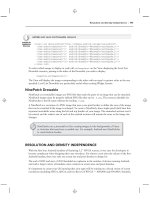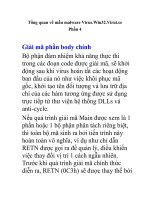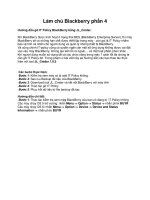Database Design Using Entity-Relationship Diagrams phần 4 ppsx
Bạn đang xem bản rút gọn của tài liệu. Xem và tải ngay bản đầy đủ của tài liệu tại đây (448.91 KB, 33 trang )
English Descriptions
We would now like to tighten the grammar that describes how a relationship
affects entities using our structural constraints, and to adopt a standard way
of stating the relationship. The standard language should appear on the
model, or at least with it. Further, using a standard language approach to
describe the ER diagrams allows us to not only close the loop with the user
in the systems analysis process, but also facilitates feedback and "nails
down" the exact meaning of the relationship.
In the Chen-like model, the double lines define full participation, as in
"automobiles fully participate in the drive relationship." Better yet, the double
lines invite us to state the relationship as:
Automobiles
must
be driven by one (and only one) student.
The
must
part comes from the full (mandatory) participation and the
one
part
from the cardinality.
The grammar for describing partial or optional relationship for the STUDENT
entity to the AUTOMOBILE entity would be:
Students
may
drive one and only one automobile.
The
may
comes from the single line leaving the STUDENT entity box and
the "one and only one" part comes from the cardinality. The point is that
when expressing the sense of the ER diagrams, one uses the language that
conveys what the relationship really means (i.e., students may drive one
automobile and automobiles must be driven by one and only one student). A
graphic on how to read an ER diagram is presented in Figure 4.3
.
Figure 4.3:
An ER Diagram of the STUDENT-AUTOMOBILE Database.
Translating the Diagram into English
Tighter English
We strongly recommend that an English sentence accompany each diagram
to reinforce the meaning of the figure. Refer to Figure 4.3
. English is often an
ambiguous language. The statement that:
Automobiles must be driven by one and only one student.
actually means that:
Automobiles, which are in the database, must be driven by one
and only one student.
It does not mean that:
One particular student drives some automobiles.
Another way to put this is:
Automobiles must be driven by one and only one student
driver. Students may drive one and only one automobile.
To relieve ambiguity in the statement of the relationship, we will take the
English statement from the relationship we have illustrated, and define four
pattern possibilities for expressing our relationship. All binary relationships
must be stated in two ways from both sides. As you will see, we will try to
stick to the exact pattern match in the following examples, but common
sense and reasonable grammar should prevail in cases where the pattern
does not quite fit. There is nothing wrong with restating the precise language
to make it more clear, but you have to say the same thing!
Pattern 1 — x:y::k:1
From the k side, full participation (k = 1 or M):
x's, which are recorded in the database, must be related to one and only one
y. No x is related to more than one y.
Example:
Student:Advisor::M:1
Students
must
be advised by one advisor.
or
Students, which are recorded in the database,
must
be
advised by one and only one advisor. No student is advised by
more than one advisor.
The phrase "which are recorded in the database" has proven to be helpful
because some database designers tend to generalize beyond the problem at
hand. For example, one could reasonably argue that there might be a case
where thus-and-so are true/not true, but the point is, will that case ever be
encountered in this particular database? The negative statement is often
helpful to solidify the meaning of the relationship.
Pattern 2 — x:y::k:1
From the k side, partial participation (k = 1 or M):
x, but not necessarily all x (which are recorded in the database), may be
related to one and only one y. Some x's are not related to a y. x's may not be
related to more than one y.
Example:
Student:Fraternity::M:1
Some students join a fraternity.
which becomes:
Students, but not necessarily all students (which are recorded
in the database),
may
join a fraternity. Some students
may
not
join a fraternity. Students may not join more than one fraternity.
Pattern 3 — x:y::k:M
From the k side, full participation (k = 1 or M):
x's, which are recorded in the database, must be related to many (one or
more) y's. Sometimes it is helpful to include a phrase such as: No x is related
to a non y (or) Non x are not related to a y. The negative will depend on the
sense of the statement.
Example:
Automobile:Student::M:N
Automobiles are driven by (registered to) many students
which means:
Automobiles, which are recorded in our database,
must
be
driven by many (one or more) students.
There are several ideas implied here. First, we are only talking about
vehicles which are registered at this school. Second, in this database, only
student cars are registered. Third, if an automobile from this database is
driven, it has to be registered and driven by a student. Fourth, the "one or
more" comes from the cardinality constraint. Fifth, there is a strong
temptation to say something about the y, the M side back to the x, but this
should be avoided as this is covered elsewhere in another pattern, and
because we discourage inferring other relationships from the one covered.
For example, one might try to say here that all students drive cars or all
students are related to a vehicle — neither statement is true.
Pattern 4 — x:y::k:M
From the k side, partial participation (k = 1 or M):
x, but not necessarily all x, (which are recorded in the database) may be
related to many (zero or more) y's. Some x may not be related to a y.
Example:
Course:Book::k:M
Some courses may require (use) many books.
which, restated, becomes:
Courses, but not necessarily all courses, (which are recorded
in the database)
may
use many (zero or more) textbooks.
Some courses
may
not require textbooks.
Note that due to partial participation (the single lines), the phrase "zero or
more," is used for cardinality. If a relationship is modeled with the patterns
we have used and then the English sounds incorrect, it may be that the
wrong model has been chosen. Generally, the grammatical expression will
be most useful in (1) restating the designed database to a naive user, and
(2) checking the meaning on the designed database among the designers.
The complete version of the English may eventually prove tiresome to a
database designer, but one should never lose track of the fact that a
statement like "x are related to one y" can be interpreted in several ways
unless it is "nailed down" with constraints stated in an unambiguous way.
Furthermore, a negation statement may be useful to elicit a requirements
definition, although at times the negation is so cumbersome it may be left off
entirely. What we are saying is to add the negative or other noncontradictory
grammar if it makes sense and helps with requirements elicitation. The
danger in adding sentences is that we may end up with contradictory or
confusing remarks.
Summary of the above Patterns and Relationships
Pattern 1:
Relationship is
x:
y
::1
(
full
)
:1
Diagramatically shown by Figure 4E
Figure 4E:
Chen Model of 1(full):1 Relationship — Pattern
1
Pattern 1:
Relationship is
x:
y
::M
(
full
)
:1
Diagramatically shown by Figure 4F
Figure 4F:
Chen Model of M(full):1 Relationship — Pattern
1
This is a very common form of a relationship which implies that an instance
of ENTITY1 can only exist for one (and only one) of ENTITY2.
Pattern 2:
Relationship is
x:
y
::1
(p
artial
)
:1
Diagramatically shown by Figure 4G
Figure 4G:
Chen Model of 1(partial):1 Relationship — Pattern
2
Pattern 2:
Relationship is
x:
y
::M
(p
artial
)
:1
Diagramatically shown by Figure 4H
Figure 4H:
Chen Model of M(partial):1 Relationship — Pattern
2
In this case, some instances in ENTITY1 and ENTITY2 can exist without the
relationship to the other entity.
Pattern 3:
Relationship is
x:
y
::1
(
full
)
:M
Diagramatically shown by Figure 4I
Figure 4I:
Chen Model of 1(full):M Relationship — Pattern
3
Pattern 3:
Relationship is
x:
y
::M
(
full
)
:N
Diagramatically shown by Figure 4J
Figure 4J:
Chen Model of M(full):N Relationship — Pattern
3
Pattern 4:
Relationship is
x:
y
::1
(p
artial
)
:M
Diagramatically shown by Figure 4K
Figure 4K:
Chen Model of 1(partial):M Relationship — Pattern
4
Pattern 4:
Relationship is
x:
y
::M
(p
artial
)
:N
Diagramatically shown by Figure 4L
Figure 4L:
Chen Model of M(partial):N Relationship — Pattern
4
Checkpoint 4.2
1. Sketch an ER diagram that shows the participation ratios (full/partial)
and cardinalities for the following:
a. Students must be advised by one advisor.
b. Students, but not necessarily all students, may join a fraternity.
Some students may not join a fraternity. Students may not join
more than one fraternity.
Our refined methodology may now be restated with the relationship
information added:
ER Design Methodology
Step 1: Select one, primary entity from the database requirements
description and show attributes to be recorded for that entity. Label
keys, if appropriate, and show some sample data.
Step 2: Use structured English for entities, attributes, and keys to
describe the database that has been elicited.
Step 3: Examine attributes in the primary entity (possibly with user
assistance) to find out if information about one of the attributes is to be
recorded.
Step 3a: If information about an attribute is needed, then make the
attribute an entit
y
, and then
Step 3b: Define the relationship back to the original entity.
Step 4: If another entity is appropriate, draw the second entity with its
attributes. Repeat step 2 to see if this entity should be further split into
more entities.
Step 5: Connect entities with relationships if relationships exist.
Step 6: State the exact nature of the relationships in structured English
from all sides. For example, if a relationship is A:B::1:M, then there is a
relationship from A(1) to B(M) and from B(M) back to A(1).
Step 7: Present the "as designed" database to the user, complete with
the English for entities, attributes, keys, and relationships. Refine the
diagram as necessary.
Step 8: Show some sample data.
Some Examples of Other Relationships
In this section, we consider three other examples of relationships — the two
1:M relationships and an M:N relationship — in more detail in order to
practice and further clarify the process we have presented.
An Example of the One-to-Many Relationship (1:M)
Relationships that are 1:M or M:1 are really relative views of the same
problem. When specifying 1:M or M:1, we need to be especially careful to
specify which entity is 1 (one) and which is M. The designation is really
which view is more natural for the database designer. As an example of a
1:M relationship, consider dorm rooms and students. One dorm room may
have many students living in it, and many students can live in one dorm
room. So, the relationship between dorm room and students would be
considered a one-to-many (1:M::DORM:STUDENT) situation and would be
depicted as in Figure 4.4
(without attributes). We let the term DORM mean
dorm room.
Figure 4.4:
An ER Diagram (without Attributes) of a 1:M
Relationship
In Figure 4.4
(the Chen-like model), the name that we chose for the DORM-
STUDENT relationship was occupy.
Note that not all dorms have students living in them, and hence the
participation of dorms in the relationship is partial. Informally,
Dorms may be occupied by many students.
Furthermore, all students may not live in dorms: therefore, the relationship of
STUDENT to DORM is also partial:
Students may occupy a dorm room.
Now let us restate the relationships in the short and long English forms. For
the first statement: "Dorms may be occupied by many students" — this fits
Pattern 4 — x:y::1(partial):M.
Pattern 4 — 1:M, from 1 side partial participation
"Some x are related to many y."
Therefore, the more precise statement is:
x, but not necessarily all x, (which are recorded in the
database) may be related to many (zero or more) y's. Some x
are not related to a y
…
.
or
Dorms, but not necessarily all dorms, (which are recorded in
the database)
may
be occupied by many (zero or more)
students.
For the inverse relationship: Students may occupy a dorm room — this fits
Pattern 2 — M(partial):1.
Pattern 2 — M(partial):1, from M side, optional participation
"Some x are related to one y."
Therefore, the long "translation" of the statement is:
x, but not necessarily all x, (which are recorded in the
database) may be related to one and only one y. Some x may
not be related to y. [No x is related to more than one y.] [
…
]
indicates optional clarification.
This x and y notation resolves into, x = students, y = dorms, and hence:
Students, but not necessarily all students, (which are recorded
in the database)
may
occupy one and only one dorm. Many
students
may
not occupy one dorm room. No student occupies
more than one dorm.
An Example of the Many-to-One Relationship (M:1)
Let us assume for a database that a school or college that we are modeling
has student parking lots. And let us further assume that every student is
assigned to park his or her car in some specific parking area. We then have
an entity called PARKING AREA, which will have parking locations that will
be described by some descriptive notation such as East Area #7, North Area
#28, etc. In this case, if we viewed many automobiles as assigned to the one
parking area and parking area as containing many automobiles, we could
depict this relationship as a many-to-one, M:1::AUTOMOBILE:PARKING
AREA. This diagram is shown in Figure 4.5
(again, without attributes).
Figure 4.5:
An ER Diagram (without Attributes) of a M:1
Relationship
We have depicted the relationship participation between automobile and
parking area as full in both instances — meaning that all automobiles have
one parking area and all parking areas are assigned to student's
automobiles.
The grammatical expressions of this relationship are:
Pattern 1 — M:1, from the M side, full participation
x, which are recorded in the database, must be related to one and only one
y. No x are related to more than one y.
x = automobile, y = parking area, relationship = park
Automobiles, which are recorded in the database, must be
parked in one and only one parking area. No automobiles may
be parked in more than one parking area.
And the inverse:
Pattern 3 — 1:M, from the 1 side, full participation
x, which are recorded in the database, must be related to many (one or
more) y's. [No x is related to a non y (or) Non x are not related to a y. (The
negative will depend on the sense of the statement.)]
Parking areas, which are recorded in the database, must park
many (one or more) automobiles. No parking areas contain
non-student automobiles.
This means that no parking areas that we are recording data about in this
database parks non-student automobiles.
An Example of the Many-to-Many Relationship (M:N)
The classic example that we will study here is students taking courses. At
the outset we know that students take (enroll in) many courses and that any
course is populated by many students. The basic diagram for the student-
course relationship is that as shown in Figure 4.6
.
Figure 4.6:
An ER Diagram (without Attributes) of a M:N
Relationship
We have chosen the word enroll to depict the relationship. The participation
of students in enroll is depicted as full (mandatory); course enrollment is
depicted as partial. This choice was arbitrary, as both could be full or partial,
depending on user needs and desires. Look carefully at the exact
grammatical expressions and note the impact of choosing full in one case
and partial in the other.
The grammatical expressions of this relationship are:
Pattern 3 — M:N, from the M side, full participation
x, which are recorded in the database, must be related to many (one or
more) y. [No x is related to a non y (or) Non x are not related to a y (or) No x
is not related to a y. (The negative will depend on the sense of the
statement.)]
x = students, y = courses, relationship = enroll
Students, which are recorded in the database,
must
be
enrolled in many (one or more) courses.
And for the inverse:
Pattern 4 — M:N, from the M side, partial participation
x, but not necessarily all x, (which are recorded in the database) may be
related to many (one or more) y. Some x may not be related to y.
x = course, y = student, relationship = enroll
Courses, but not necessarily all courses, (which are recorded
in the database) may enroll many (one or more) students.
Some courses may not enroll students.
This "course partiality" likely reflects courses that are in the database, but
are not currently enrolling students. It could mean potential courses, or
courses that are no longer offered. Of course, if the course is in the database
only if students are enrolled, then the participation constraint becomes full
and the sense of the entity relationship changes.
Also, this database tells us that while we can have courses without students,
we only store information about active students. Obviously we could make
the student connection partial and hence store all students — even inactive
ones. We chose to make the relationships the way we did to make the point
that the participation constraint is to depict reality — the reality of what the
user might want to store data about.
Note that all the examples in this chapter deal with only two entities; that is,
they are binary relationships. The example in the following section provides
yet another example of a binary relationship.
Checkpoint 4.3
1. Give an example of a 1(full):1 relationship? Does such a relationship
always have to be mandatory? Explain with examples.
2. Give an example of a 1(partial):1 relationship? Does such a
relationship always have to be optional? Explain with examples.
3. Give an example of an M(full):N relationship? Would such a
relationship always be optional or mandatory? Explain with examples.
4. Give an example of an M(partial):N relationship? Would such a
relationship always be optional or mandatory? Explain with examples.
One Final Example
As a final example to conclude the chapter, we present one more problem
and the methodology.
[1]
Consider a model for a simplified airport that records
PASSENGERS and FLIGHTS. Suppose that the attributes of PASSENGER
are name, articles of luggage, and frequent flyer number. Suppose the
attributes for FLIGHT are flight number, destination, time of departure, and
estimated time of arrival. Draw the ER diagram.
Note: We are leaving out many things (attributes) that we could consider
about our airport; but for the sake of an example, assume that this is all the
information that we choose to record.
Here is the solution:
ER Design Methodology
Step 1: Select one, primary entity from the database requirements
description and show attributes to be recorded for that entity. Label
keys if appropriate and show some sample data.
Suppose we choose PASSENGER as our primary entity. PASSENGER has
the following attributes: frequent flier #, name [first, middle, last], articles of
luggage. We draw this much of the diagram, choosing frequent flier # as a
key and noting the composite attribute, name. This diagram is shown in
Figure 4.7
.
Figure 4.7:
The PASSENGER Entity Diagram
Step 2: Use structured English for entities, attributes, and keys to
describe the database that has been elicited.
The Entity
This database records data about PASSENGERS. For each
passenger, we record the following: frequent flier #, name [first,
middle, last], articles of luggage.
The Attributes
For atomic attributes, att(j):
For each PASSENGER, there always will be one and only one
frequent flier #. The value for frequent flier # will not be
subdivided.
For each PASSENGER, there always will be one and only one
recording of articles of luggage. The value for articles of
luggage will not be subdivided.
For composite attributes, att(j):
For each PASSENGER, we will record their name, which is
composed of first, middle, and last. First, middle, and last are
the component parts of name.
The Keys
For each PASSENGER, we will have the following primary key:
frequent flier #.
Note that we have chosen frequent flier # as a primary key for
PASSENGER. If this were not true, some other means of unique
identification would be necessary. Here this is all the information we are
given.
Step 3: Examine attributes in the primary entity (possibly with user
assistance) to find out if information about one of the attributes is to be
recorded. No further information is suggested.
Step 4: If another entity is appropriate, draw the second entity with its
attributes. Repeat step 2 to see if this entity should be further split into
more entities.
The other entity in this problem is FLIGHT with the following attributes: flight
#, destination, depart time, arrive time.
Again, we use the structured English:
The Entity
This database records data about Flights. For each FLIGHT, we record:
flight #, destination, depart time, and arrive time.
The Attributes
For atomic attributes, att(j):
For each FLIGHT, there always will be one and only one
flight#. The value for flight# will not be subdivided.
For each FLIGHT, there always will be one and only one
recording of destination. The value for destination will not be
subdivided.
For each FLIGHT, there always will be one and only one
recording of depart time. The value for depart time will not be
subdivided.
For each FLIGHT, there always will be one and only one
recording of arrive time. The value for arrive time will not be
subdivided.
The Keys
For the key(s): (b) One candidate key (strong entity):
For each FLIGHT, we will have the following primary key:
flight#. We are assuming flight # is unique.
Step 5: Connect entities with relationships if relationships exist.
What Relationship Is There between Flights and Passengers?
All passengers will fly on a flight. All flights will have multiple passengers.
The diagram for this problem is illustrated in Figure 4.8
and Figure 4.9. Note
that we have again made a choice: we will depict one flight per passenger in
this database. The specifications do not tell us whether this should be 1 or
M, so we chose 1. We also chose full participation on both sides. It would
seem illogical to record data about passengers who did not fly on a flight and
flights where there were no passengers. But again, if the database called for
storing information about potential passengers who might not book a specific
flight or flights that did not involve passengers, then we would have to
change the conceptual design. Figure 4.8
is good for displaying just the
entities and the attributes. Figure 4.9
uses the concise form of describing
attributes and also includes some steps from above and some sample data.
For conceptualizing, Figure 4.8
may be used, and later converted into Figure
4.9 style for documentation. Either figure requires an accompaniment of
structured English (step 6).
Figure 4.8:
Sample Problem
Figure 4.9:
Sample Problem: Alternate Presentation of Attributes with
Explanation and Sample Data
Step 6: State the exact nature of the relationships in structured English
from all sides. For example, if a relationship is A:B::1:M, then there is a
relationship from A(1) to B(M) and from B(M) back to A(1).
Pattern 1 — M:1, from the M side, full participation
x, which are recorded in the database, must be related to one and only one
y. No x are related to more than one y.
x = passenger, y = flight, relationship = fly
Passengers, which are recorded in the database,
must
fly on
one and only one flight. No passenger flies on more than one
flight.
Pattern 3 — 1:M, from the 1 side, full participation
x, which are recorded in the database, must be related to many (one or
more) y's.
x = flight, y = passenger, relationship = fly
Flights, which are recorded in the database,
must
fly many
(one or more) passengers.
Attribute descriptions follow previous patterns.
Step 7: Present the "as designed" database to the user, complete with
the English for entities, attributes, keys, and relationships. Refine the
diagram as necessary.
Step 8: Show some sample data.
See Figure 4.9
.
[1]
Modeled after Elmasri and Navathe (2000).
Mapping Relationships to a Relational Database
In this section we will continue with the mapping rules that we began at the
end of Chapter 2
. In Chapter 2 we learned how to map entities, entities with
composite attributes, and entities with multi-valued attributes. In this chapter,
having covered structural constraints of relationships, we will learn how to
map relationships.
1.
Identify the entities:
Passenger, Flight
2.
Add attributes to entities, identifying primary keys:
Passenger (name[last, first, mi]. frequent flier #, # articles of luggage)
Flight (flight #, destination, depart time, arrive time)
3.
What relationship is there
between Passengers and Flights?
Passengers fly on flights.
Our first mapping rule for mapping relationships maps binary M:N
relationships.
M3a — For binary M:N relationships: For each M:N
relationship, create a new table (relation) with the primary
keys of each of the two entities (owner entities) that are
being related in the M:N relationship. The key of this new
table will be the concatenated keys of the owner entities.
Include any attributes that the M:N relationship may have
in this new table.
For example, refer to Figure 4.6
. If the STUDENT and COURSE tables have
the following data:
STUDENT
name.first name.last name.mi student_number address
Richard Earp W 589 222 2nd
St.
Boris Backer
909 333
Dreistrasse
Helga Hogan H 384 88 Half
Moon Ave.
Arpan Bagui K 876 33 Bloom
Ave
Hema Malini
505 100
Livingstone
COURSE
cname c_number credit_hrs
Database COP4710 4
Visual Basic CGS3464 3
Before performing the M3a mapping rule, one must first insure that the
primary keys of the entities involved have been established. If
student_number and c_number are the primary keys of STUDENT and
COURSE, respectively, then to map the M:N relationship, we create a
relation called ENROLL, as follows:
Both c_number and student_number together are the primary key of the
relation, ENROLL.
Our next set of mapping rules for mapping relationships maps binary 1:1
relationships:
M3b — For binary 1:1 relationships: Include the primary
key of Entity A into EntityB as the foreign key.
The question is: which is EntityA and which is EntityB? This question is
answered in the next three mapping rules: M3b_1, M3b_2, and M3b_3.
M3b_1 — For binary 1:1 relationships, if one of the sides
has full participation in the relationship, and the other has
partial participation, then store the primary key of the side
with the partial participation constraint on the side with
the full participation constraint. Include any attributes of
the relationship on the side that gets the primary key (the
primary key now becomes the Foreign key in the new
relation).
For example, refer to Figure 4.2
. It says:
An automobile, recorded in the database,
must
be driven by
one and only one student.
and
Elements of Stats STA3023 3
Indian History HIST2022 4
ENROLL
c_number student_number
COP4710 589
CGS3464 589
CGS3464 909
STA3023 589
HIST2022 384
STA3023 505
STA3023 876
HIST2022 876
HIST2022 505
A student may drive one and only one automobile.
Here, the full participation is on the AUTOMOBILE side since "An automobile
‘must’ be driven by a student."
So we take the primary key from the partial participation side, STUDENT,
and include it in the AUTOMOBILE table. The primary key of STUDENT is
student_number, so this will be stored in the AUTOMOBILE relation as the
foreign key. A relational database realization of the ER diagram in Figure 4.2
with some data would look like this:
Since STUDENT has a multi-valued attribute school, we need the table
below to map the multi-valued attribute.
AUTOMOBILE
vehicle_id make body_style color year student_number
A39583 Ford Compact Blue 1999 589
B83974 Chevy Compact Red 1989 909
E98722 Mazda Van Green 2002 876
F77665 Ford Compact White 1998 384
STUDENT
name.first name.last name.mi student_number address
Richard Earp W 589 222 2nd St
Boris Backer
909 333
Dreistrasse
Helga Hogan H 384 88 Half
Moon Ave
Arpan Bagui K 876 33 Bloom
Ave
Hema Malini
505 100
Livingstone
Name-School
student_number school
589 St. Helens
589 Mountain
589 Volcano
909 Manatee U
909 Everglades High
384 PCA









